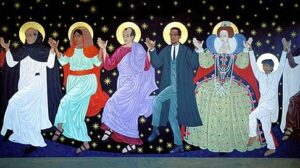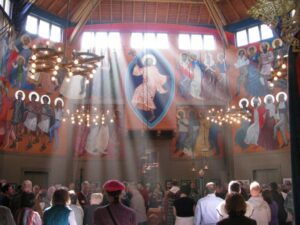All Saints’, Dorval
July 11, 2021

People are dancing through our scriptures this morning.
When his daughter Herodias came in and danced, she pleased Herod and his guests; and the King said to the girl, “Ask me for whatever you wish, and I will give it.”
David and all the house of Israel were dancing before the Lord with all their might, with songs and lyres and harps and tambourines and castanets and cymbals.
Based on this sample of two stories, though, one would be hard pressed to know what to think about dancing. The dancing of Herodias (who, confusingly, seems to have the same name as her mother, Herod’s wife) is the occasion of a sacrilegious crime – the beheading of John the Baptist, an innocent man caught in a snare of politics, guilt, adultery, bloodlust and arrogance among the elite of Galilee.
David’s dancing, on the other hand, is liturgical dancing: a joyous expression of his devotion to God. When his wife Michal “despises him in her heart” for it – apparently because she thinks a linen ephod (basically, a loincloth) is insufficient clothing and that his behavior is undignified – God renders her childless, thus ending the royal line of Saul on the throne of Israel. (That bit got left out of the lectionary passage.)
So, basically, it depends: who is doing the dancing, and why, and in what context? And I think what it all boils down to is, are you dancing for God?
David – for all his manifest failings as a person, husband, father and king – was dancing for God. Herodias, though she seems to have been basically a naïve and innocent participant in her parents’ bloody intrigues, allowed herself to be manipulated into dancing for reasons that had far more to do with her father’s self-promotion, greed, and ambition than with any genuine impulse to share something beautiful with the world.
If you think of dancing as a metaphor for something much larger – living your life, expressing your gifts, showing your inner self to the world – this becomes a very pertinent question. Are you dancing for God? Or are you dancing to manipulate, to seduce, to mask your fears, to lie, or to bolster the ego of yourself or others?
And how do you know if you’re dancing for God?
There is a long and proud tradition in Christian history, both of actual liturgical dancing like David’s, and of using dance as a metaphor for the life of faith. Think of songs like “The Lord of the Dance” or “My Dancing Day.” And of course this understanding is not confined to Christianity; think of the whirling of Sufi dervishes, the ecstatic dancing of Hasidic Jews, or Shaker dancing, to name only a few of the most familiar examples. In many of these traditions, dancing is also associated with healing.
One key characteristic of all these kinds of dance is that none of them are done alone. Even whirling dervishes, though their interaction during the ceremony is minimal, dance together with others. David is accompanied in his dancing before the Lord by “all the house of Israel”. Herodias, on the other hand, dances alone (though egged on by her mother) as a form of display. Which is not to say that solos are somehow inherently sinful, or even that our God-given gifts for our lives cannot be expressed when we are alone – but that in the larger picture of life, we are always strongest within a community.
Dancing together with others is a profound expression of unity in diversity. Different movements and different skill levels combine to create something that is greater than the contribution of any of the participants. The parallel to the community of faith is clear: our gifts are complementary, and are most effective when combined into one great dance. We may take turns as the principal dancer, but the dance of God is fundamentally communal.
And when we undertake it in faith and trust, the dance of God transforms us. In a sermon preached at the Episcopal Church’s General Convention in 2012, on the feast of St. Benedict, the Rev’d Stephanie Spellers offered this meditation on the Benedictine values of stability and conversion of life:
To be Christian is to engage in a dance. To be Anglican is to engage in a dance. Stabilitas [stability] keeps us anchored, holding fast to what is holy and true. Conversatio morum [conversion of life] makes us free to say, “Here is the way we have known Jesus. May this path bless you. How have you known him? What song sounds like God to you? What dream has the Spirit whispered to you in your ear? I am confused, I am scared. But I embrace this dying and rising, this sacrifice and blessing, this transformation into the fullness of Christ. And, I embrace you.” The prayer to be like Benedict will shatter our well-drawn boundaries, it breaks our hearts, it grows our capacity to love and to fail, and sends us humble as beggars into the arms of Jesus and the arms of the stranger. It is a dangerous prayer. Pray it anyway. And then watch out. God might just give you what you prayed for.
The Episcopal Church of St. Gregory of Nyssa, in San Francisco, has an enormous wall painting around all four sides of their sanctuary (roughly three thousand square feet of wall space), in the style of an Orthodox icon, showing saints, with their hands on each other’s shoulders, dancing a traditional liturgical line dance. The dance mirrors the actual dancing of the congregation, who do this simple line dance together at every service as they move from the service of the word to the gathering around the communion table. King David is there, along with Mary Magdalene, Shakespeare, Gandhi, Black Elk, and eighty-six others.
St. Gregory’s was founded by a pair of priests, Rick Fabian and Donald Schell (who, as it happens, my parents have known well since the 1970s), According to a blog post by Victoria Emily Jones, they “commissioned the Dancing Saints Icon in 1997 to give visual expression to the theology of the church’s patron saint, Gregory, who lived in the fourth century. In his commentary on the Psalms, St. Gregory wrote, ‘Once there was a time when the whole rational creation formed a single dancing chorus looking upward to the one leader of this dance. And the harmony of motion that they learned from his law found its way into their dancing.’”

The St. Gregory’s congregation in action
If you were to be included in that icon, what would your figure look like? What symbols would you bring? What is unique about the way the dance of God is expressed in you – and how do you dance that dance with the other people in your life?
Dancing is frequently planned and choreographed, of course, but it can also be an expression of spontaneous joy. Some of the most wonderful moments in worship, for me, are when people just can’t keep still, and break out into dance – little girls at a baptism on All Saints’ Day, twirling in the aisles to “When the Saints go Marching In”, or that time in Advent 2019 when Dion and Amanda Seebeck ended up swinging each other around like folks dancers at the end of the recessional.
And wonderful things happen when dancers meet, even if their styles are very different. There are several groups in Canada that perform the traditional Indian dance known as bhangra, and this excerpt from a documentary about one of them shows them encountering Indigenous dancers on the west coast and discovering how much they have in common.
If that isn’t dancing for God, I don’t know what is.
When this was posted on Twitter, commenters piped up at the similarities not only between the two groups of dancers but to Jewish wedding dances, Irish step dancing, the New Zealand haka, and other forms of traditional dance.
Now imagine how different the world would be if, when cultures encountered each other, instead of exploiting and oppressing each other, they simply danced together. Imagine how that would rejoice God’s heart.
When you dance, dance for God – and for each other. And that dance just might heal the world.
Amen.
I will dance for God. I promise. Thank you for this beautiful sermon, Rev. Grace.